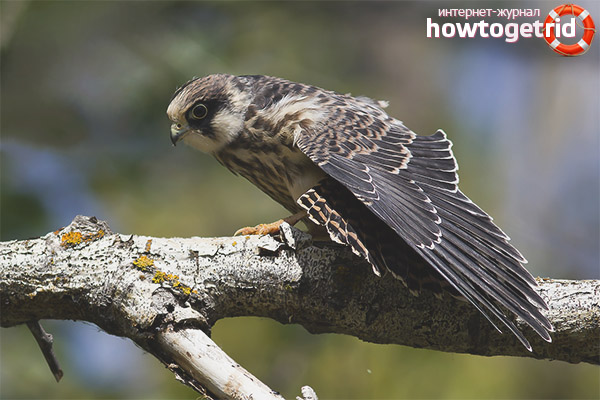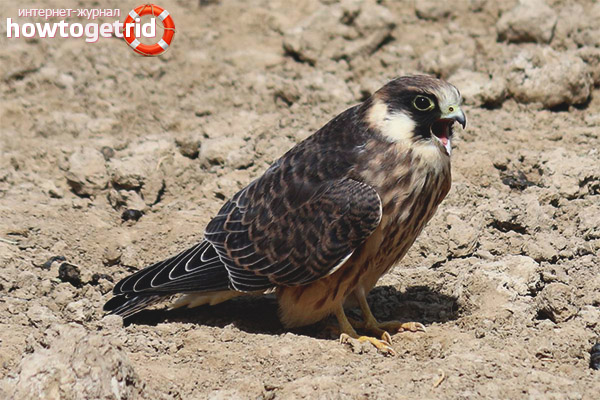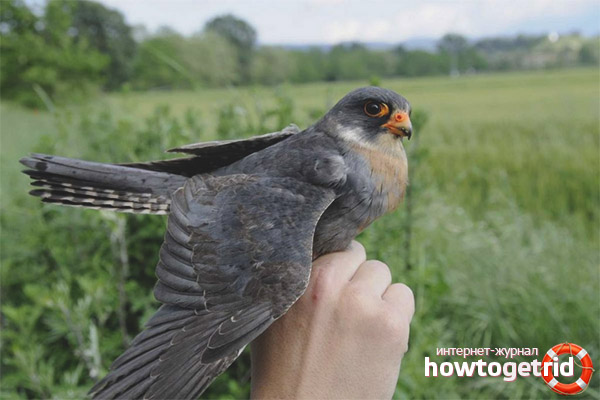The content of the article
Small falcon is a bird of prey, the genus is falcons. Its size is smaller than the usual falcon, but it is very similar to it.
Kobets - in the old days they called small falcons. The hunters gave this name to the cheglock. “Kobchik” or “kobets” as a book name was fixed in the XVIII century and even entered the French language. The view of a fawn from Latin is translated as “evening”, but in fact it is most active in the daytime, usually hunts in the afternoon. English, Czech, German name - red-legged falcon.
Lives in a very large territory, in the forest-steppe zone, in Eastern Europe and near Lake Baikal, in the northern city of Yeniseisk and by the Vilyuy River. He loves open spaces, does not live in continuous forests. It can be found in the steppes, forest-steppes, parks, large felling areas, near rivers, swamps. It is a migratory bird. Flies away to winter in southern Africa.
Description
Body length - 28-33 cm, wings - 25-35 cm, their wingspan is 65-77 cm. Individuals weigh 130-197 grams.
The color of the males is dark gray, almost black, the stomach, “pants” on the legs and the area under the tail are red. Females are buffy in color; there are many longitudinal streaks on the abdomen; transverse stripes on the back, tail, and wings, face with black “antennae”. The iris is dark brown. The claws on the paws are whitish brown. They have a short, not very strong beak. Only born chicks are “dressed” in white fluff. As they grow older, they become brown in color with a light belly and with longitudinal streaks. Beak with a blue tint. Over time, more and more like an adult bird. The area around the eyes, waxen and paws in adults is reddish or orange, in young ones - yellowish.
Habitat
The habitat is located in Eurasia, from Eastern Europe to Lake Baikal, the Vilyui River. Another species, called the Amur falcon, inhabits east. The bird can be found in Russia, Ukraine, Kazakhstan, Belarus. However, it is not nested in all regions. It is often found in some places, and in some - it does not exist at all.
For the winter, these birds fly to South Africa or Asia. They fly in a solid flock, which differs from other species of falcons. They migrate to Africa in the summer, in August, and return to their native lands in May.
Frenzy live in groups, from a few to a hundred pairs. Lonely predators are a rarity. Ravens and magpies settle in empty nests, rooks, sometimes in niches, burrows, hollows. They love artificial nests, they themselves never make them. They form settlements for one year or several years. During their mating season, many insects breed, it happens quite late.
Nutrition

The males are predators. They are small in size and can catch the appropriate food. Therefore, these birds usually feed on large enough insects (bugs, dragonflies). In Africa, they like to profit from locusts. If they do not find bugs, they can catch small rodents. In addition, they even catch small snakes and lizards. Less commonly eat sparrows and larger birds - pigeons. During the hunt, predators fly above the ground and look for prey. Having noticed the victim, they begin to flap their wings more often and can freeze for a moment in the air, then they rush sharply down and catch it from the ground. If the prey has already moved, they can run after it on its paws. These birds are fast, very mobile. On the fly, they catch insects, like other falcons, with their paws, not their beak.
Kobchik benefits agriculture. In the place where he lives, there are fewer insect pests: locusts, beetles. He also protects his territory from other birds that eat seeds from the fields. It can accompany herds on pastures; there are enough insects climbing around them.
Frenzy can be kept in captivity, feed, like other birds of prey. It’s even easier with them, because over time they get used to various foods and eat almost any food.
Breeding
From wintering places birds return later than others - in May. Then they begin the mating season. Frenchies usually have several eggs (3-6), ocher color is usually rusty, their female hatch a little less than a month (25-28 days). The male feeds her. Often, it also helps to incubate eggs. During the hunt, this little falcon sings songs. It produces high sounds “qi-ki-ki” and “ki-ki-ki” in various forms. You can hear his voice while he is caring for a female or if you scare him. During nesting, the dog’s songs are heard quite often.
Chicks grow, stay near the nesting place for two weeks. Very voracious, like all other birds, parents feed them from morning to evening. In early July, they begin to learn to fly. By August, they are already flying great and find food themselves. By the time you need to fly to the warm regions for the winter, young individuals are able to take care of themselves and fly on such a long journey. They become sexually mature a little earlier than a year.
Interesting Facts
- These predators live for 12-16 years, and in captivity - up to 18 years. Inhabitants of Africa tame mares, collect small flocks from them for several years. Birds no longer fly away to nesting sites. They catch insects, mice and other pests in the fields of their owners, in this way, increasing productivity.
- Pups always live in packs, males help the female during hatching eggs. During this period, they are more difficult to catch. The birds are quite calm and peaceful, give themselves to tame and listen to the owner. Only because of the love of flying often fly away from the owner. In the old days, their wings were cut so that they could not fly far. But, at the same time, there were other cases when people nursed a bird, let it fly away, and it flew back with prey.
- These small predators often attack such a large, in comparison with them, bird, such as a heron. However, they do this not for the purpose of making money with her, but in order to take her nest.
- Birds are of great benefit in increasing pests on agricultural land, destroying them and, thereby, “healing” the field.
- This bird of prey is always on the alert and fears humans. Near her, you must be extremely careful. If the little fellow considers that something is threatening him, sharp claws and a hard beak will be used.
Today, these falcons are listed in the Red Book. This species is becoming less common, has a status of “being in a state close to threatened,” and needs protection. The number of red dogs is constantly decreasing. Hunting these birds in a large number of countries is prohibited by law. The use of chemicals in agriculture is particularly conducive to reducing their numbers. Their fodder area decreases, because of this the reproduction of birds also suffers. To protect the falcon, it is necessary to prohibit cutting down large trees in the steppes along river valleys, and to promote the protection of the species among the rural population. Identify habitats, create wildlife sanctuaries with special measures for the conservation of small fox.
Video: Pussycat (Falco vespertinus)











Submit